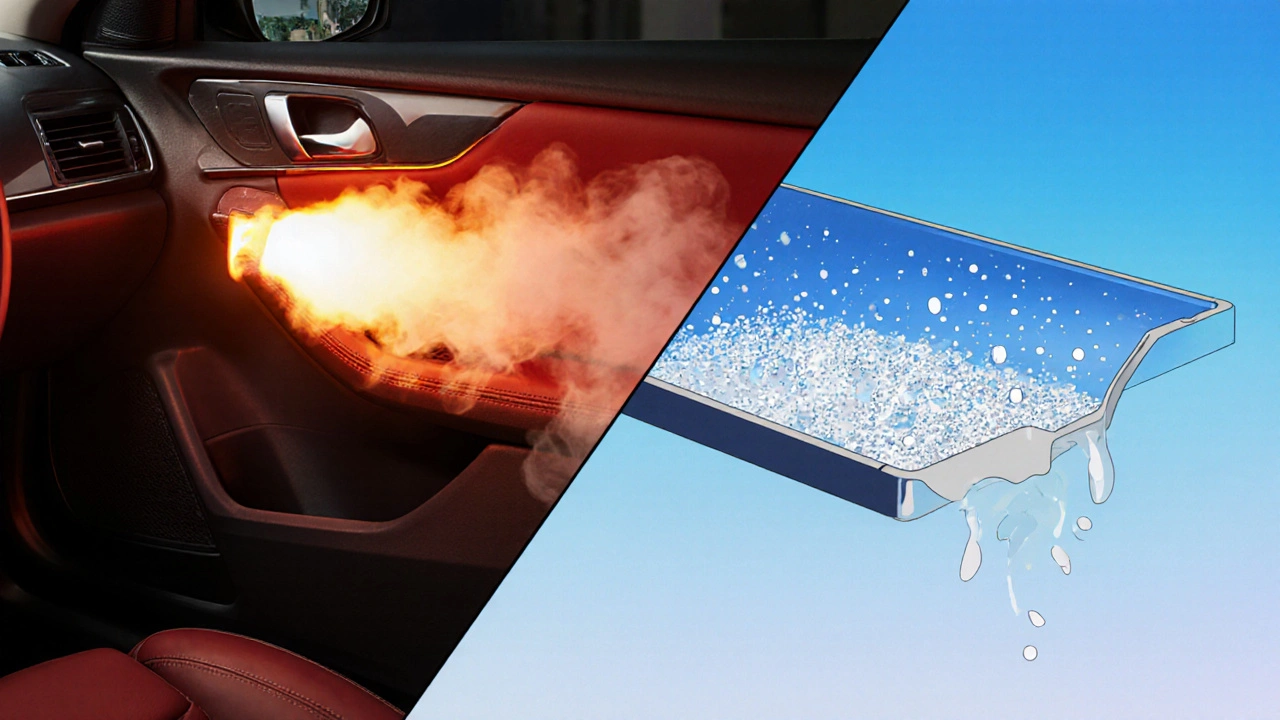When engineers need a material that won’t catch fire, stays strong at high temperatures, and can be recycled, they often turn to aluminium hydroxide. This simple inorganic compound does more than just slow down flames - it can change the way composite structures behave under stress, heat, and even after their service life ends.
What is aluminium hydroxide?
Aluminium hydroxide is a white, fire‑resistant inorganic compound with the formula Al(OH)₃. It’s produced by reacting aluminium salts with alkaline solutions and is widely available as a fine powder. Its key property for materials engineers is the ability to absorb heat while releasing water vapor when exposed to temperatures above 180 °C.
Why aluminium hydroxide works as a flame retardant
When a polymer starts to burn, the temperature spikes and volatile gases feed the flame. Aluminium hydroxide intervenes in two ways:
- Endothermic decomposition: The compound absorbs about 1 kJ g⁻¹ of heat as it breaks down, lowering the surrounding temperature.
- Water release: The released steam dilutes flammable gases and creates a barrier that slows heat transfer.
Because the process is purely physical - no toxic gases or heavy metals are released - it meets strict environmental regulations in Europe and North America.
Integrating aluminium hydroxide into composite materials
Composite materials consist of a polymer matrix that binds together reinforcing fibers or particles. Adding aluminium hydroxide can be done at the powder‑mixing stage, during melt extrusion, or as a surface coating on pre‑formed parts.
When the filler is ground to the nano‑scale - often called a nanofiller - its surface area spikes, meaning less material is needed to achieve the same flame‑retardant effect. This also helps preserve the mechanical properties that engineers value.

Performance benefits after the addition
Researchers have measured several quantitative gains when aluminium hydroxide is incorporated at 20‑30 wt % in typical thermosets:
- Heat deflection temperature (HDT): Increases by 30‑45 °C, allowing parts to stay in service longer under load.
- Mechanical reinforcement: Tensile strength drops less than 5 % compared with unfilled resin, thanks to the nanofiller’s ability to bridge microcracks.
- Smoke suppression: Optical density of the smoke plume is cut by roughly 40 % in standard UL‑94 tests.
- Thermal stability: The composite retains its weight‑loss onset temperature above 350 °C, a clear sign of improved thermal stability.
These numbers mean lighter, safer parts for automotive, aerospace, and construction sectors.
Environmental and safety advantages
Unlike brominated flame retardants, aluminium hydroxide is inert, non‑carcinogenic, and fully recyclable. After a component reaches the end of its life, the filler can be reclaimed by simple water washing, leaving a clean aluminium‑rich residue that can be fed back into the production loop.
Because the compound does not contain halogens, it does not produce dioxins or furans during combustion - a major selling point for manufacturers aiming for green certifications such as REACH compliance.
Practical processing guidelines
Getting the most out of aluminium hydroxide requires attention to a few processing details:
- Particle size: Aim for sub‑500 nm for optimal dispersion; larger particles tend to settle and create weak spots.
- Mixing method: High‑shear twin‑screw extruders ensure uniform distribution and prevent agglomeration.
- Dosage: 20‑30 wt % balances flame retardancy with mechanical strength; exceeding 35 wt % can make the composite brittle.
- Curing schedule: A gradual temperature ramp (e.g., 2 °C min⁻¹ up to 180 °C) allows the filler to decompose gently, avoiding premature water release that could cause bubbles.
Testing with differential scanning calorimetry (DSC) and thermogravimetric analysis (TGA) helps verify that the filler behaves as expected during the cure cycle.

Real‑world case studies
Automotive interior panels: A European car maker replaced 25 wt % magnesium hydroxide with aluminium hydroxide in its door‑trim composite. The new panels passed the same UL‑94 V‑0 rating but were 12 % lighter and produced half the smoke in fire tests.
Aerospace brackets: A US aerospace supplier used a nanofilled epoxy‑aluminium hydroxide system for bolt‑on brackets. The brackets withstood 250 °C for 30 minutes without losing 10 % of their load‑bearing capacity, outperforming traditional glass‑fiber/epoxy brackets.
Construction insulation boards: In a pilot project in Scandinavia, insulation boards containing 30 wt % aluminium hydroxide demonstrated a 40 % reduction in fire spread across a wall assembly, meeting stringent fire‑code requirements without sacrificing R‑value.
Key takeaways
- Aluminium hydroxide provides a non‑toxic, endothermic flame‑retardant action.
- When used as a nanofiller, it preserves mechanical strength while boosting thermal stability.
- It improves smoke suppression and meets strict environmental regulations.
- Proper particle size, mixing, and curing are essential for optimal performance.
- Successful industrial applications span automotive, aerospace, and building sectors.
Frequently Asked Questions
Can aluminium hydroxide be used with thermoplastic matrices?
Yes. It mixes well with polyamide, polypropylene, and polystyrene. The key is to keep the processing temperature below the filler’s decomposition point until the melt is fully formed, then raise it briefly to trigger the endothermic reaction.
How does aluminium hydroxide compare to magnesium hydroxide?
Both are inorganic flame retardants, but aluminium hydroxide releases water at a lower temperature (≈180 °C vs. ≈340 °C for magnesium hydroxide). This makes it more effective for polymers that melt at lower temperatures. However, magnesium hydroxide offers higher load‑bearing capacity at similar filler levels.
Is the filler recyclable after a product’s life‑cycle?
Because the compound is water‑soluble after combustion, it can be washed out and recovered as an aluminium‑rich slurry. This slurry can be filtered, dried, and reused in new composites, reducing raw‑material demand.
What safety precautions are needed during handling?
Wear a dust mask and goggles to avoid inhaling fine powder. The material is non‑reactive under normal conditions, but avoid prolonged exposure to high humidity, which can cause premature agglomeration.
Does the addition of aluminium hydroxide affect the color of the final part?
It imparts a slightly milky hue at high loadings, but pigments can be added to mask the effect without sacrificing flame‑retardant performance.
| Property | Aluminium hydroxide | Magnesium hydroxide | Brominated FR |
|---|---|---|---|
| Decomposition temp. | ≈180 °C | ≈340 °C | ≈250 °C |
| Water release (wt %) | ~25 % | ~15 % | ~0 % |
| Toxic by‑products | None | None | Halogenated dioxins |
| Typical loading (% wt) | 20‑30 | 25‑35 | 5‑15 |
| Effect on tensile strength | -5 % (at 30 %) | -3 % (at 30 %) | -12 % (at 10 %) |

naoki doe
October 26, 2025 AT 19:48Aluminium hydroxide isn’t just a filler; it actually participates in the cure chemistry of many thermosets.
By absorbing heat at around 180 °C it can flatten the temperature peak that normally drives rapid polymer degradation.
The released steam also acts as a physical barrier, throttling the flame’s access to volatile gases.
When you keep the particle size sub‑500 nm, the dispersion stays even and you avoid the dreaded weak spots.
In practice that translates to a modest weight gain but a noticeable boost in HDT for automotive interiors.
Joy Dua
October 27, 2025 AT 08:26The alchemical dance of water and aluminium within the polymer matrix evokes a subtle choreography of thermal inertia and smoke mitigation.
Such inorganic elegance sidesteps the toxic theatrics of halogenated retardants whilst preserving mechanical poise.
Barna Buxbaum
October 27, 2025 AT 22:20If you’re scaling up the nanofiller route, start with a high‑shear twin‑screw extruder to keep the particles from agglomerating.
A gradual temperature ramp of about 2 °C per minute lets the filler decompose smoothly and avoids bubble formation.
Keep an eye on the viscosity; a sudden drop often signals premature water release.
The resulting composite typically shows a 30 °C improvement in heat deflection temperature with less than a five‑percent loss in tensile strength.
Overall it’s a relatively low‑cost upgrade for anyone needing fire‑safe parts.
Abbey Travis
October 28, 2025 AT 05:16Don’t forget to run a TGA on a small batch before committing to full production; it catches moisture issues early.
ahmed ali
October 29, 2025 AT 02:06Alright, let me break this down because most people just skim the glossy tables and nod.
First off, aluminium hydroxide, when reduced to nanoparticle size, does more than just sit there like a passive filler – it actively interacts with the polymer network during cure.
The endothermic decomposition at roughly 180 °C sucks up heat, which in turn slows down the rate at which the matrix softens, and that is a big deal for high‑temperature applications.
Secondly, the water vapor that is liberated creates a micro‑atmosphere of steam that dilutes combustible volatiles, effectively choking the flame out before it can gain momentum.
Now, you might wonder why anyone would bother with a 20‑30 wt % loading when it seemingly adds bulk, but the reality is that the nanofiller’s high surface area means you need far less mass to achieve the same fire‑retardant performance as bulk powders.
In fact, studies have shown a reduction in required loading by up to 40 % when you go nano, which helps preserve tensile strength.
Speaking of strength, the filler can actually bridge micro‑cracks, acting like a tiny scaffolding that distributes stress more evenly across the composite.
This is why you often see less than a five‑percent drop in tensile strength even at the upper loading limits.
Moreover, the smoke suppression numbers are impressive – cutting optical density by around forty percent translates to better visibility for rescue crews in a fire scenario.
From an environmental standpoint, the fact that aluminium hydroxide is inert and recyclable makes it a preferable alternative to brominated retardants that leach toxic dioxins.
The recycling process is straightforward: simply wash the post‑combustion residue with water, filter out the aluminium‑rich slurry, and you have a feedstock ready for reuse.
Of course, handling the fine powder does require proper PPE – a dust mask and goggles are non‑negotiable – because prolonged inhalation of the dust can irritate the lungs.
Also, be mindful of humidity during storage; too much moisture can cause the particles to clump, making dispersion harder.
Finally, when you integrate this filler into a thermoplastic like polyamide, watch the processing window closely; you want to stay below the decomposition temperature until the melt is fully formed, then give it a brief temperature spike to activate the endothermic reaction.
All in all, it’s a versatile tool that, when used correctly, boosts fire safety without sacrificing the mechanical integrity you need for demanding applications.
Deanna Williamson
October 29, 2025 AT 09:03While the benefits are clear, the cost implications of high‑grade nano‑aluminium hydroxide can be non‑trivial for small manufacturers.
Miracle Zona Ikhlas
October 30, 2025 AT 05:53A quick moisture bake before compounding can further improve filler dispersion.
Samantha Taylor
October 30, 2025 AT 12:50One would think that a simple bake would be beyond the grasp of seasoned engineers, yet the data suggests otherwise.
Joe Langner
October 31, 2025 AT 09:40Keep in mind that the composite’s influeence on overall weight is minuscule, so you can still hit your fuel efficiency goals without compromising safety.
Ben Dover
October 31, 2025 AT 16:36The epistemological ramifications of substituting halogenated retardants with inorganic hydroxides merit rigorous scholarly discourse.
Katherine Brown
November 1, 2025 AT 13:26It is incumbent upon materials scientists to document the thermogravimetric profiles with utmost precision, thereby facilitating reproducibility across institutional boundaries.
Ben Durham
November 1, 2025 AT 20:23From a cross‑cultural engineering perspective, sharing these standardized protocols accelerates global adoption of greener flame‑retardant technologies.